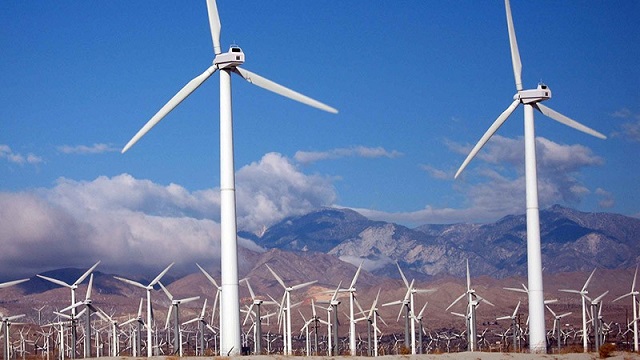Economy
‘Gambling With The Grid’: New Data Highlights Achilles’ Heel Of One Of Biden’s Favorite Green Power Sources

 From the Daily Caller News Foundation
From the Daily Caller News Foundation
By NICK POPE
New government data shows that wind power generation fell in 2023 despite the addition of new capacity, a fact that energy sector experts told the Daily Caller News Foundation demonstrates its inherent flaw.
Wind generation fell by about 2.1% in 2023 relative to 2022 generation, despite the 6 gigawatts (GW) of wind power capacity that came online last year, according to data published Tuesday by the U.S. Energy Information Administration (EIA). That wind power output dropped despite new capacity coming online and the availability of government subsidies highlights its intermittency and the problems wind power could pose for grid reliability, energy sector experts told the DCNF.
The decrease in wind generation is the first drop on record with the EIA since the 1990s; the drop was not evenly distributed across all regions of the U.S., and slower wind speeds last year also contributed to the decline, according to EIA. The Biden administration wants to have the American power sector reach carbon neutrality by 2035, a goal that will require a significant shift away from natural gas- and coal-fired power toward wind, solar and other green sources.

A table depicting the decrease of wind power generation in 2023 relative to 2022. (Screenshot via U.S. Energy Information Administration)
“Relying on wind power to meet your peak electricity demands is gambling with the grid,” Isaac Orr, a policy fellow at the Center of the American Experiment who specializes in power grid-related analysis, told the DCNF. “Will the wind blow, or won’t it? This should be a moment where policymakers step back and consider the wisdom of heavily subsidizing intermittent generators and punishing reliable coal and gas plants with onerous regulations.”
Between 2016 and 2022, the wind industry received an estimated $18.6 billion worth of subsidies, about 10% of the total amount of subsidies extended to the energy sector by the U.S. government, according to an August 2023 EIA report. Wind power received more assistance from the government than nuclear power, coal or natural gas over the same period of time.
“This isn’t subsidies per kilowatt hour of generation. It’s raw subsidies. If it were per kilowatt hour of generation, the numbers would be even more extreme,” Paige Lambermont, a research fellow at the Competitive Enterprise Institute, told the DCNF. “This is a massive amount of money. It’s enough to dramatically alter energy investment decisions for the worse. We’re much more heavily subsidizing the sources that don’t provide a significant portion of our electricity than those that do.”
“Policy that just focuses on installed capacity, rather than the reliability of that capacity, fails to understand the real needs of the electrical grid,” Lambermont added. “This recent disparity illustra
Wind power’s performance was especially lackluster in the upper midwest, but Texas saw more wind generation in 2023 than it did in 2022, according to EIA. Wind generation in the first half of 2023 was about 14% lower than it was through the first six months of 2022, but generation was higher toward the end of 2023 than it was during the same period in 2022.
In 2023, about 60% of all electricity generated in the U.S. came from fossil fuels, while 10% came from wind power, according to EIA data. Beyond generous subsidies for preferred green energy sources, the Biden administration has also aggressively regulated fossil fuels and American power plants to advance its broad climate agenda.
Biden’s Climate Bill Boosted An Offshore Wind Giant, But His Economy Brought It To The Brink https://t.co/AF7SPT2FNu
— Daily Caller (@DailyCaller) November 3, 2023
The Environmental Protection Agency’s (EPA) landmark power plant rules finalized this month will threaten grid reliability if enacted, partially because the regulations are likely to incentivize operators to close plants rather than adopt the costly measures required for compliance, grid experts previously told the DCNF. At the same time that the Biden administration is effectively trying to shift power generation away from fossil fuels, it is also pursuing goals — such as substantially boosting electric vehicle adoption over the next decade and incentivizing construction of energy-intensive computer chip factories — that are driving up projected electricity demand in the future.
“The EIA data proves what we’ve always known about wind power: It is intermittent, unpredictable and unreliable,” David Blackmon, a 40-year veteran of the oil and gas industry who now writes and consults on the energy sector, told the DCNF. “Any power generation source whose output is wholly dependent on equally unpredictable weather conditions should never be presented by power companies and grid managers as safe replacements for abundant, cheap, dispatchable generation fueled with natural gas, coal or nuclear. This is a simple reality that people in charge of our power grids too often forget. Saying that no doubt hurts some people’s feelings, but nature really does not care about our feelings.”
Blackmon also pointed out that, aside from its intermittency, sluggish build-out of the transmission lines and related infrastructure poses a major problem for wind power.
“Wind power is worthless without accompanying transmission, yet the Biden administration continues to pour billions into unreliable wind while ignoring the growing crisis in the transmission sector,” Blackmon told the DCNF.
Another long-term issue that wind power, as well as solar power, faces is the need for a massive expansion in the amount of battery storage available to store and dispatch energy from intermittent sources as market conditions dictate. By some estimates, the U.S. will need about 85 times as much battery storage by 2050 relative to November 2023 in order to fully decarbonize the power grid, according to Alsym Energy, a battery company.
The White House and the Department of Energy did not respond to requests for comment.
Business
Fuelled by federalism—America’s economically freest states come out on top

From the Fraser Institute
Do economic rivalries between Texas and California or New York and Florida feel like yet another sign that America has become hopelessly divided? There’s a bright side to their disagreements, and a new ranking of economic freedom across the states helps explain why.
As a popular bumper sticker among economists proclaims: “I heart federalism (for the natural experiments).” In a federal system, states have wide latitude to set priorities and to choose their own strategies to achieve them. It’s messy, but informative.
New York and California, along with other states like New Mexico, have long pursued a government-centric approach to economic policy. They tax a lot. They spend a lot. Their governments employ a large fraction of the workforce and set a high minimum wage.
They aren’t socialist by any means; most property is still in private hands. Consumers, workers and businesses still make most of their own decisions. But these states control more resources than other states do through taxes and regulation, so their governments play a larger role in economic life.
At the other end of the spectrum, New Hampshire, Tennessee, Florida and South Dakota allow citizens to make more of their own economic choices, keep more of their own money, and set more of their own terms of trade and work.
They aren’t free-market utopias; they impose plenty of regulatory burdens. But they are economically freer than other states.
These two groups have, in other words, been experimenting with different approaches to economic policy. Does one approach lead to higher incomes or faster growth? Greater economic equality or more upward mobility? What about other aspects of a good society like tolerance, generosity, or life satisfaction?
For two decades now, we’ve had a handy tool to assess these questions: The Fraser Institute’s annual “Economic Freedom of North America” index uses 10 variables in three broad areas—government spending, taxation, and labor regulation—to assess the degree of economic freedom in each of the 50 states and the territory of Puerto Rico, as well as in Canadian provinces and Mexican states.
It’s an objective measurement that allows economists to take stock of federalism’s natural experiments. Independent scholars have done just that, having now conducted over 250 studies using the index. With careful statistical analyses that control for the important differences among states—possibly confounding factors such as geography, climate, and historical development—the vast majority of these studies associate greater economic freedom with greater prosperity.
In fact, freedom’s payoffs are astounding.
States with high and increasing levels of economic freedom tend to see higher incomes, more entrepreneurial activity and more net in-migration. Their people tend to experience greater income mobility, and more income growth at both the top and bottom of the income distribution. They have less poverty, less homelessness and lower levels of food insecurity. People there even seem to be more philanthropic, more tolerant and more satisfied with their lives.
New Hampshire, Tennessee, and South Dakota topped the latest edition of the report while Puerto Rico, New Mexico, and New York rounded out the bottom. New Mexico displaced New York as the least economically free state in the union for the first time in 20 years, but it had always been near the bottom.
The bigger stories are the major movers. The last 10 years’ worth of available data show South Carolina, Ohio, Wisconsin, Idaho, Iowa and Utah moving up at least 10 places. Arizona, Virginia, Nebraska, and Maryland have all slid down 10 spots.
Over that same decade, those states that were among the freest 25 per cent on average saw their populations grow nearly 18 times faster than those in the bottom 25 per cent. Statewide personal income grew nine times as fast.
Economic freedom isn’t a panacea. Nor is it the only thing that matters. Geography, culture, and even luck can influence a state’s prosperity. But while policymakers can’t move mountains or rewrite cultures, they can look at the data, heed the lessons of our federalist experiment, and permit their citizens more economic freedom.
Business
The world is no longer buying a transition to “something else” without defining what that is

From Resource Works
Even Bill Gates has shifted his stance, acknowledging that renewables alone can’t sustain a modern energy system — a reality still driving decisions in Canada.
You know the world has shifted when the New York Times, long a pulpit for hydrocarbon shame, starts publishing passages like this:
“Changes in policy matter, but the shift is also guided by the practical lessons that companies, governments and societies have learned about the difficulties in shifting from a world that runs on fossil fuels to something else.”
For years, the Times and much of the English-language press clung to a comfortable catechism: 100 per cent renewables were just around the corner, the end of hydrocarbons was preordained, and anyone who pointed to physics or economics was treated as some combination of backward, compromised or dangerous. But now the evidence has grown too big to ignore.
Across Europe, the retreat to energy realism is unmistakable. TotalEnergies is spending €5.1 billion on gas-fired plants in Britain, Italy, France, Ireland and the Netherlands because wind and solar can’t meet demand on their own. Shell is walking away from marquee offshore wind projects because the economics do not work. Italy and Greece are fast-tracking new gas development after years of prohibitions. Europe is rediscovering what modern economies require: firm, dispatchable power and secure domestic supply.
Meanwhile, Canada continues to tell itself a different story — and British Columbia most of all.
A new Fraser Institute study from Jock Finlayson and Karen Graham uses Statistics Canada’s own environmental goods and services and clean-tech accounts to quantify what Canada’s “clean economy” actually is, not what political speeches claim it could be.
The numbers are clear:
- The clean economy is 3.0–3.6 per cent of GDP.
- It accounts for about 2 per cent of employment.
- It has grown, but not faster than the economy overall.
- And its two largest components are hydroelectricity and waste management — mature legacy sectors, not shiny new clean-tech champions.
Despite $158 billion in federal “green” spending since 2014, Canada’s clean economy has not become the unstoppable engine of prosperity that policymakers have promised. Finlayson and Graham’s analysis casts serious doubt on the explosive-growth scenarios embraced by many politicians and commentators.
What’s striking is how mainstream this realism has become. Even Bill Gates, whose philanthropic footprint helped popularize much of the early clean-tech optimism, now says bluntly that the world had “no chance” of hitting its climate targets on the backs of renewables alone. His message is simple: the system is too big, the physics too hard, and the intermittency problem too unforgiving. Wind and solar will grow, but without firm power — nuclear, natural gas with carbon management, next-generation grid technologies — the transition collapses under its own weight. When the world’s most influential climate philanthropist says the story we’ve been sold isn’t technically possible, it should give policymakers pause.
And this is where the British Columbia story becomes astonishing.
It would be one thing if the result was dramatic reductions in emissions. The provincial government remains locked into the CleanBC architecture despite a record of consistently missed targets.
Since the staunchest defenders of CleanBC are not much bothered by the lack of meaningful GHG reductions, a reasonable person is left wondering whether there is some other motivation. Meanwhile, Victoria’s own numbers a couple of years ago projected an annual GDP hit of courtesy CleanBC of roughly $11 billion.
But here is the part that would make any objective analyst blink: when I recently flagged my interest in presenting my research to the CleanBC review panel, I discovered that the “reviewers” were, in fact, two of the key architects of the very program being reviewed. They were effectively asked to judge their own work.
You can imagine what they told us.
What I saw in that room was not an evidence-driven assessment of performance. It was a high-handed, fact-light defence of an ideological commitment. When we presented data showing that doctrinaire renewables-only thinking was failing both the economy and the environment, the reception was dismissive and incurious. It was the opposite of what a serious policy review looks like.
Meanwhile our hydro-based electricity system is facing historic challenges: long term droughts, soaring demand, unanswered questions about how growth will be powered especially in the crucial Northwest BC region, and continuing insistence that providers of reliable and relatively clean natural gas are to be frustrated at every turn.
Elsewhere, the price of change increasingly includes being able to explain how you were going to accomplish the things that you promise.
And yes — in some places it will take time for the tide of energy unreality to recede. But that doesn’t mean we shouldn’t be improving our systems, reducing emissions, and investing in technologies that genuinely work. It simply means we must stop pretending politics can overrule physics.
Europe has learned this lesson the hard way. Global energy companies are reorganizing around a 50-50 world of firm natural gas and renewables — the model many experts have been signalling for years. Even the New York Times now describes this shift with a note of astonishment.
British Columbia, meanwhile, remains committed to its own storyline even as the ground shifts beneath it. This isn’t about who wins the argument — it’s about government staying locked on its most basic duty: safeguarding the incomes and stability of the families who depend on a functioning energy system.
Resource Works News
-

 Crime15 hours ago
Crime15 hours agoTerror in Australia: 12 killed after gunmen open fire on Hanukkah celebration
-

 Energy2 days ago
Energy2 days agoCanada’s future prosperity runs through the northwest coast
-

 Crime15 hours ago
Crime15 hours agoHero bystander disarms shooter in Australian terror attack
-

 Business22 hours ago
Business22 hours agoInflation Reduction Act, Green New Deal Causing America’s Energy Crisis
-

 Business1 day ago
Business1 day agoFuelled by federalism—America’s economically freest states come out on top
-

 Daily Caller1 day ago
Daily Caller1 day ago‘There Will Be Very Serious Retaliation’: Two American Servicemen, Interpreter Killed In Syrian Attack
-

 illegal immigration2 days ago
illegal immigration2 days agoUS Notes 2.5 million illegals out and counting
-

 Automotive1 day ago
Automotive1 day agoPoliticians should be honest about environmental pros and cons of electric vehicles



